Design of hipped roof - device and diagrams
The choice of the type of roof for the project of the future construction is a very important stage of construction. Error in this question is expensive: the integrity of the image is destroyed, harmony and respectability disappear. Architects and designers often recommend a hipped roof to cover a large house with their own hands. Her device successfully combines a recognizable appearance, reliability and practicality, before which no homeowner can resist.


Appearance and design
The roof of the four-slope type consists of four intersecting planes, slopes. Two of them, triangular in shape, called the end, they replace the gables. The remaining two - trapezoidal, known as the facade. The range of the slope of the slopes lies in the range of 15-60 degrees, and the choice of roofing material limits only the imagination. The design of the hip roof consists of the following mandatory elements:

- Skate, located at the very top of the roof, at the intersection of the slopes.
- Slopes, four surfaces angled to the base of the roof and covered with roofing material.
- Overhangs, parts of the roof, protruding beyond the perimeter of the base, necessary to protect the walls of the building from water ingress. Overhangs are formed by lengthening the rafter legs or special parts - fillies.
- The truss system, which is not visible from the outside, but it is the frame, the support of the hipped roof, forming its geometry.
- Drainage system, providing abstraction of excess fluid from the surface chetyrehskatnoy roof. Usually, an external gutter is assembled, consisting of a gutter, a water intake funnel, and a vertical pipe.
- Snegozaderzhateli, small sides located along the edges of the slopes, preventing the sudden collapse of snow accumulated after the snowfall.
Varieties of forms
Under the term “chetyrekhskatnaya” there are several types of roofs, consisting of such a number of slopes, but having a different device:
- Четырехскатная вальмовая. Классическое прочтение, кровля с четырьмя скатами, два из которых треугольные, а два трапециевидные. Они соединяются, образуя конек, длина которого меньше, чем длина дома. Sling system вальмовой кровли относится к конструкциям повышенной сложности, ее тяжело и спроектировать и собрать своими руками.
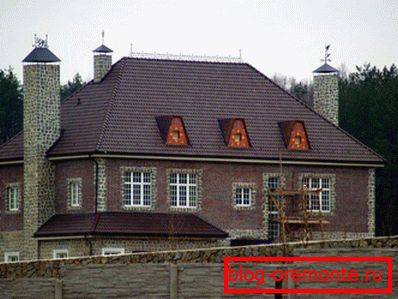
- Chetyrehvalmovaya Dutch four. Objectively reasoning, this view can be attributed to the dual-slope and chetyrekhskatnymi roofs. The Dutch roof consists of two slopes in the form of a trapezoid and two small, triangular, truncated hips. Hips do not completely replace the gables, making it possible to install conventional vertical windows instead of roof windows, which are much more expensive.

- Half-hardened chetyrehskatnaya Danish. Danish roof consists of four slopes in the form of trapezoids, differing in size. Hips do not start from the ridge, but slightly lower, leaving a place under the triangular pediment. Pediment is used for equipment with their own hands vertical lighting or dormer window.
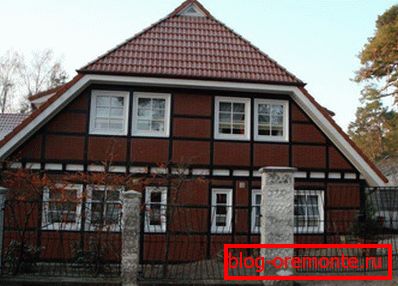
- Four-pitched mansard. It consists of two triangular hips and two broken slopes and a variable angle of inclination. Such a complex device is necessary in order to equip residential attic space with a high ceiling.
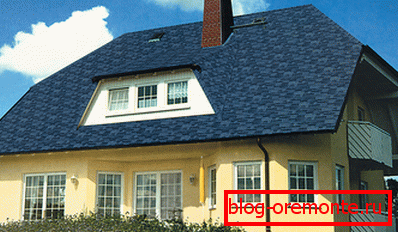
- Tent chetyrekhskatnaya. In contrast to the hip, hip roof is mounted on the buildings of a square shape. Therefore, all four slopes have the same triangular shape and size. The roof of the hip type does not provide for the presence of a ridge, as the slopes are connected at one point, the peak.
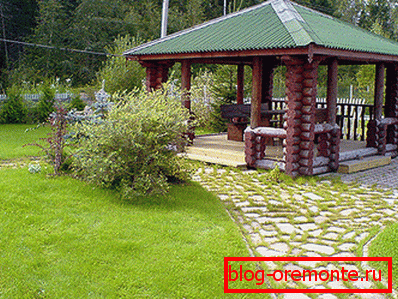
Design
The four-pitch roof is a complex structure that requires precise calculations and a project. If earlier these tasks were done only by experienced craftsmen and designers, now everyone can solve them with the help of a computer and special software. In the course of calculations, a scheme is drawn up and determined:
- The angle of slope of the sloping roof. This parameter is influenced by the selected roofing material, the wind and snow load value. If you do your own calculations, you can use reference tables with ready angles for different climatic zones.
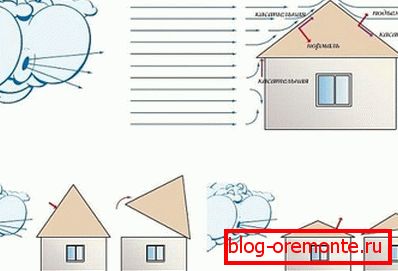
- The height of the ridge of the hip roof. It depends only on the angle of slope of the slopes and the desired height of the ceiling of the attic room.
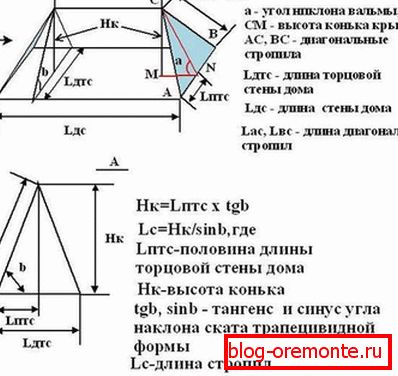
- The length and cross section of the elements of the truss system. They are determined after determining the permanent and temporary loads that they have to bear. To do this, calculate the total weight of the roofing pie, floors and attic floor, support elements. And also checked with data on snow load.

- The number of additional items. If the length of the rafters and other parts of the truss system exceeds 6 meters, then additional components are introduced into the structure, increasing its strength and stability.
The result of the design process is the scheme that reflects the actual size and relative position of the parts of the hip roof.

Sling system
The four-pitch roof rests on a frame called the truss system. Almost all its elements are made of coniferous wood. Since wood is a material of natural origin, moisture and bacteria have a devastating effect on it. To reduce its conduct antiseptic treatment of deep penetration and fire retardant to protect against fire. The truss system of the four-slope roof includes:

- Mauerlat The support made of a bar which distributes the weight of a roof on perimeter of bearing walls.
- Racks. Vertical support elements, which are installed on the floor or beams of the ceiling to prevent the deflection of rafter legs.
- Rafter legs. The diagonal rafters form the edges of the hip slope of the roof, they are mounted with one side to the ridge, and the other to different corners of the mauerlat. The surface of the hip is set by ladders, fixed to the diagonal legs. Ordinary rafters serve as a support for trapezoid rays.

- Tightening. A horizontally positioned beam tightening the legs of the truss pair to prevent the walls from spreading.
- Strut They are set at an angle to the rafter legs in order to eliminate the deflection, and they rest against the struts in the racks or the power plate.
- Ridge run. The bar connecting the upper parts of the pillars, it serves as a support for roof pairs.
- Crate. The basis for the flooring of the roofing master. For soft, rolled mount solid crate, and for solid lattice.
The installation of a four-sided roof with its own hands is a great way to complement the architectural design of a private house. With efforts and building it yourself or hiring professional craftsmen, the homeowner will become the owner of a comfortable, beautiful home!